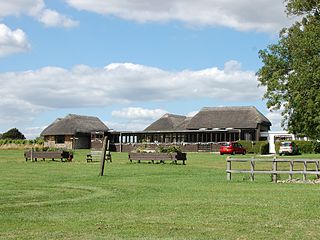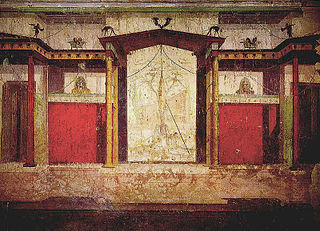Related Research Articles

Fishbourne Roman Palace is in the village of Fishbourne, Chichester in West Sussex. The palace is the largest Roman residence north of the Alps, and has an unusually early date of 75 AD, around thirty years after the Roman conquest of Britain.

Baiae was an ancient Roman town situated on the northwest shore of the Gulf of Naples and now in the comune of Bacoli. It was a fashionable resort for centuries in antiquity, particularly towards the end of the Roman Republic, when it was reckoned as superior to Capri, Pompeii, and Herculaneum by wealthy Romans, who built villas here from 100 BC. Ancient authors attest that many emperors built in Baia, almost in competition with their predecessors and they and their courts often stayed there. It was notorious for its hedonistic offerings and the attendant rumours of corruption and scandal.

The Villa Poppaea is an ancient luxurious Roman seaside villa located in Torre Annunziata between Naples and Sorrento, in Southern Italy. It is also called the Villa Oplontis or Oplontis Villa A. as it was situated in the ancient Roman town of Oplontis.

Chedworth Roman Villa is located near Chedworth, Gloucestershire, England and is a scheduled monument. It is one of the largest and most elaborate Roman villas so far discovered in Britain and one with the latest occupation beyond the Roman period. The villa was built in phases from the early 2nd century to the 5th century, with the 4th-century construction transforming the building into an elite dwelling arranged around three sides of a courtyard. The 4th-century building included a heated and furnished west wing containing a dining-room (triclinium) with a fine mosaic floor, as well as two separate bathing suites: one for damp-heat and one for dry-heat.

Cottanello is a comune (municipality) in the Province of Rieti in the Italian region of Latium, located about 60 kilometres (37 mi) north of Rome and about 15 kilometres (9 mi) west of Rieti.

Bignor Roman Villa is a large Roman courtyard villa which has been excavated and put on public display on the Bignor estate in the English county of West Sussex. It is well known for its high quality mosaic floors, which are some of the most complete and intricate in the country.

Brading Roman Villa was a Roman courtyard villa which has been excavated and put on public display in Brading on the Isle of Wight.

Littlecote Roman Villa is an extensive and exceptional Roman villa, with associated religious complex, at Littlecote Park just over a mile west of Hungerford, Berkshire. It has been excavated and is on display to the public in the grounds of the estate.

The Welwyn Roman Baths are a Roman ruin preserved under the A1(M) just north of modern-day Welwyn Garden City, Hertfordshire, England. The baths were a small part of the Dicket Mead villa, which was originally built in the 3rd century AD.

Horace's Villa is a large ancient Roman villa complex near Licenza, Italy. The identification is likely because Horace wrote several poems about the place, and the special elaborate architectural features and location of the villa correspond to the descriptions in the poetry.

Newport Roman Villa was a Romano-British farmhouse constructed in 280 AD. It is located near to Newport, Isle of Wight.

Oplontis is an ancient Roman archaeological site located in the town of Torre Annunziata, south of Naples in the Campania region of southern Italy. The excavated site comprises two Roman villas, the best-known of which is Villa A, the so-called Villa Poppaea.

The House of Augustus, or the Domus Augusti, is situated on the Palatine Hill in Rome, Italy. This house has been identified as the primary place of residence for the emperor Augustus.

North Leigh Roman Villa was a Roman courtyard villa in the Evenlode Valley about 0.5 miles (800 m) north of the hamlet of East End in North Leigh civil parish in Oxfordshire. It is a scheduled monument in the care of English Heritage and is open to the public.

Folkestone Roman Villa, also referred to as the East Bay Site, is a villa built during the Roman Occupation of Britain, and is located in East Wear Bay near the port town of Folkestone, in Kent, England. The villa is situated on a cliff top overlooking the English Channel, with views of the French coast at Boulogne on a clear day. It is situated near the start of the North Downs Trackway, and the area has been inhabited for thousands of years, with archeological finds in the area and at the villa site dating back to the Mesolithic and Neolithic ages. The villa was built around A. D. 75, and was almost certainly built within the confines of a preexisting Iron Age settlement.

The Keston Roman villa is an archaeological site in Keston in the London Borough of Bromley, England. The villa consisted of several buildings including a mausoleum. The latter is preserved above ground.

Boxmoor Roman Villa is a ruined Roman Villa at Boxmoor, Hemel Hempstead, Hertfordshire. The remains have been excavated, but they are now buried. The Roman villa was occupied from the first century AD up to the Fourth century.
Northchurch Roman Villa is a ruined Roman villa at Northchurch, Hertfordshire. The site was excavated in 1973 due to new housing developments on the site.
At Eccles in Kent the remains of a huge Roman Villa with palatial dimensions were excavated between 1962 and 1976. In the second century AD, the villa was almost 112 m long. Over 135 different rooms have been identified throughout the various periods of construction and reconstruction. The villa was abandoned in the Fourth century and much of it was removed in the Thirteenth century for the construction of Aylesford Priory.

Bucknowle Roman villa is a Roman villa in Dorset, England. It is located within a camping site within the grounds of Bucknowle Farm.
References
- ↑ J.B. Ward Perkingsː The Roman Villa at Lockleys, Welwyn, inː Antiquaries Journal XVIII , October 1938, p. 8
- ↑ Perkings, inː Antiquaries Journal XVIII, pp. 8-9
- ↑ Perkings, inː Antiquaries Journal XVIII ,p. 11-13
- ↑ Perkings, inː Antiquaries Journal XVIII, pp. 13-16
- ↑ Perkings, inː Antiquaries Journal XVIII, pp. 16-17
